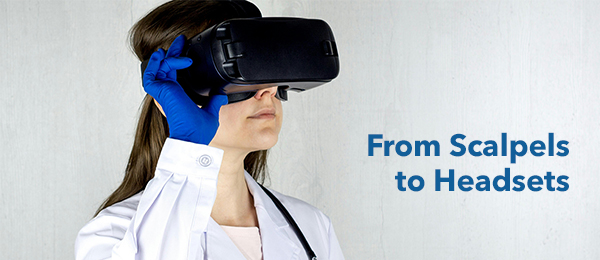
From Scalpels to Headsets: The OLC’s Virtual Reality Advantage
From Scalpels to Headsets: The OLC’s Virtual Reality Advantage
In a glass building just outside Chicago, a group of orthopaedic surgeons don virtual reality headsets and begin operating on a patient’s knee. Their hands move through empty air, manipulating virtual surgical tools with uncanny precision. But this is no video game—it’s the cutting edge of surgical training at the OLC, where the next generation of bone doctors are mastering their craft in the metaverse.
For three decades, the OLC has been at the forefront of surgical education, evolving from basic arthroscopy courses to today’s immersive digital experiences. As virtual and augmented reality reshape medical training, this unassuming facility in Rosemont, Illinois finds itself once again at the vanguard of a revolution in how we teach the intricate art of orthopaedic surgery.
From Projection Screens to Projecting Realities
When the OLC first opened its doors in 1994, personal computers were still novelties in many households. But forward-thinking orthopaedists recognized their potential for enhancing surgical education. Early computer classes at the OLC introduced surgeons to digital tools for planning procedures and analyzing outcomes.
In those early days, it was considered a significant achievement to get everyone comfortable using a mouse. Even then, early adopters knew computers would transform surgery, even if they couldn’t quite imagine how.
Fast forward to 2021, and those same surgeons, along with a new generation of digital natives, were guiding robotic arms with millimeter precision.
This evolution was swift and relentless. From early 2000s simulations allowing surgeons to practice in pixels, to the 2015 launch of a state-of-the-art facility with global reach, the OLC consistently pushed the boundaries of surgical education. The introduction of robotic surgery courses in 2021 marked another milestone, with the OLC hosting certifications for major orthopaedic companies like DePuy and Stryker.
The introduction of robotic surgery courses was considered a watershed moment. It opened up new possibilities in surgical precision and minimally invasive techniques that are still being explored today.
These robotic surgery courses represented a quantum leap in precision and control. They covered everything from basic controls to complex procedural simulations, allowing trainees to practice intricate surgeries without risk to real patients.
But even as robotic surgery was making waves, another technological revolution was brewing on the horizon: augmented and virtual reality (AR/VR).
It has been noted that AR/VR can complement existing training methods. They offer unprecedented immersion and interactivity. The focus is no longer just on teaching surgery, but on transforming pre-surgical planning and intra-operative decision making.
Recent studies back this up. VR-trained surgeons show significant improvements in performance and error reduction. AI-powered AR systems enhance real-time surgical precision by overlaying 3D patient models onto the operating field.
“It’s a game-changer,” says Lisé Puckorius, CAE, CEO of the OLC. “They’re not replacing traditional techniques, but they’re certainly enhancing them in ways we couldn’t have imagined even a few years ago.”
Pixels and Polygons: Extending the Legacy of Donations
While cadavers remain an invaluable resource, AR/VR technologies can dramatically extend their educational impact. The combination of live demonstrations with immersive digital experiences is creating a learning environment that honors and maximizes the precious gift of donors.
There is a constant search for ways to amplify their contribution to medical science.
Indeed, traditional surgical labs with their hands-on experiences remain crucial, while VR is envisioned to revolutionize how students prepare for these vital sessions beforehand.
Haptic feedback gloves provide a sense of touch, while high-resolution displays offer views impossible in traditional surgery. This immersive experience is designed to better prepare surgeons, ensuring that when they step into the actual lab, they’re ready to make the most of their hands-on time.
The advantages extend beyond the wow factor. VR simulations can be paused, rewound, and repeated ad infinitum. Rare complications can be programmed in at will. And perhaps most importantly, the system has the potential to provide objective feedback on a trainee’s performance.
Augmenting Reality in the Operating Room
While VR is changing the training paradigm at the OLC, AR is making inroads into real operating rooms. AR systems overlay digital information onto the surgeon’s view of the physical world, typically via specialized glasses or a headset.
It has been suggested that having all the patient’s relevant scans, real-time vital signs, and other key data right in the field of view as one operates would be beneficial. AR allows for bringing all that information into the OR without taking eyes off the patient.
Early AR systems in orthopaedics focused on improving the accuracy of implant placement in joint replacements. By superimposing a digital plan onto the surgeon’s view, AR can guide the precise positioning of artificial hips and knee joints.
But the technology’s potential goes far beyond that. Researchers at Johns Hopkins University are developing AR systems that can highlight hidden anatomical structures, like blood vessels and nerves, reducing the risk of accidental injury. Other teams are working on AR-assisted minimally invasive techniques that could make surgery less traumatic for patients.
The Virtual Learning Curve
For all its promise, the shift to AR/VR training hasn’t been without challenges. The OLC is currently piloting new teaching modalities, as well as educating its own lab staff.
It has been acknowledged that there’s definitely a learning curve. Some of the most experienced surgeons initially struggle with the technology. But once they get over that hump, most become converts.
Another hurdle has been proving the effectiveness of VR training compared to traditional methods. While early studies have been promising, long-term data on real-world surgical outcomes is still limited.
“The future of medicine is being shaped by technology that enhances—not replaces—the skill and judgment of surgeons.” says Gregg Nicandri, MD, Chief Medical Information Officer and Professor of Orthopedic Surgery at University of Rochester Medical Center. “At the OLC, surgeons can engage directly with emerging tools and techniques that are redefining how we learn, operate, and improve patient outcomes.”
The Future is (Virtually) Here
Despite these challenges, the OLC and its partners remain excited on the future of AR/VR in orthopaedics and other medical disciplines. They’re already exploring the next frontier: artificial intelligence.
It is anticipated that AI systems will be able to analyze a trainee’s performance in VR and provide personalized feedback and training plans. Eventually, AI-powered virtual patients that can respond realistically to different treatment approaches are envisioned, allowing for even more comprehensive training scenarios.
As these technologies mature, they’re likely to reshape not just surgical training, but the entire field of surgery.
For the OLC, it’s just the latest chapter in a three-decade story of embracing the cutting edge. From those first fumbling mouse clicks to today’s virtual operations, the OLC has consistently pushed the boundaries of surgical education.
“The technology may change, but our mission remains the same,” concludes Lisé Puckorius, CEO. “We’re here to train the best orthopaedic surgeons possible, using whatever tools can help us achieve that goal.”
As the next group of trainees adjusts their VR headsets and prepares to dive into a virtual knee replacement, one can’t help but wonder: what impossible-seeming technology will the OLC be teaching in another 30 years?

